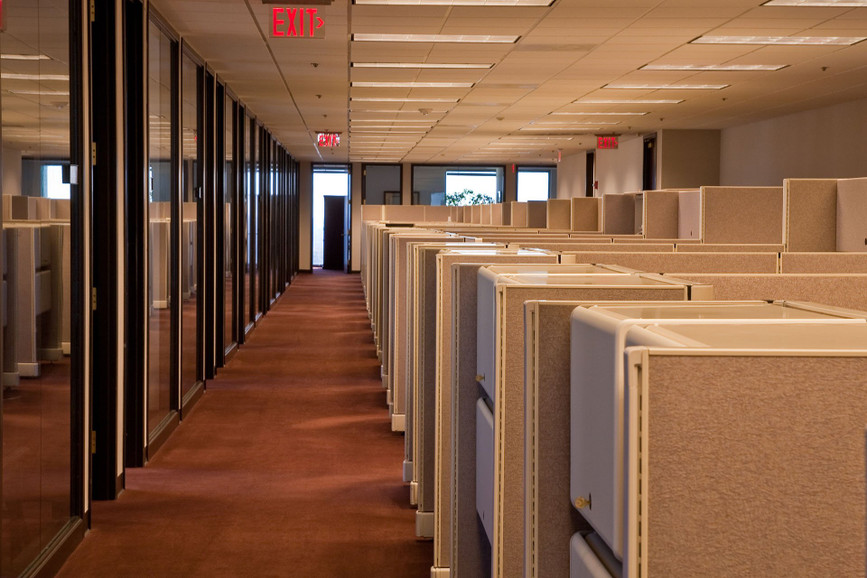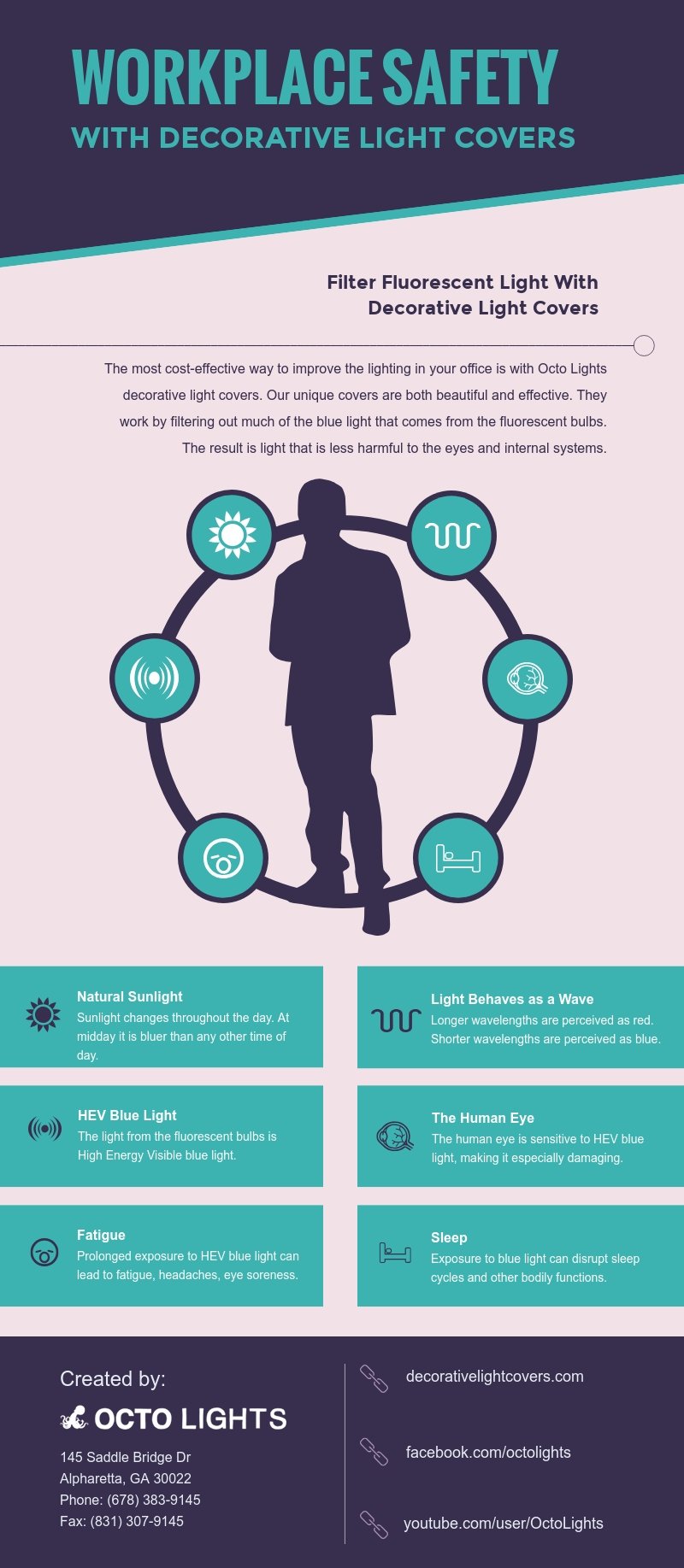
Workplace Safety with Decorative Light Covers
28th Feb 2019
There is nothing more important in the workplace than workplace safety. No matter how great a company is to work for, no matter how well they pay or how happy their workers are, if a worker suffers preventable harm on the job, their employer is not doing their job. If you run a business, or even if you just run a single office, the safety of your workers should be of paramount concern. You would never let your workers work in an office that was contaminated with mold, asbestos, or lead. You would similarly bring in an electrician immediately if the outlets were sparking or there was even the smallest danger of an electrical fire. But many employers are unknowingly subjecting their workers, day in and day out, to harm from above. If your workers are toiling under unfiltered fluorescent light, you may be doing them harm you aren’t even aware of. Decorative light covers can help.

HEV Blue Light
Before we can talk about the details of fluorescent light, we need to define what light is in the first place. If you recall from your high school physics class, light is the common name for electromagnetic radiation. It acts as both a wave and a particle, though we often speak of it solely in terms of its wave-like properties. Light with long wavelengths includes radio waves, microwaves, and infrared light. Visible light has a relatively short wavelength. On the longer wavelength end of the visible spectrum, light appears red. On the shorter end, light appears blue. Even shorter wavelength light includes ultraviolet light, x-rays, and gamma rays.
While the human eye can only interpret a relatively narrow range of light wavelengths, it does not perceive all wavelengths equally. Obviously, there is the color difference. The brain interprets different wavelengths as different colors. But besides the colors, the anatomy of the human eye is more sensitive to some kinds of light than others. On the blue end of the spectrum, the human eye is particularly sensitive to high energy visible (HEV) blue light.
Due to the body’s particular sensitivity to HEV blue light, light at the short wavelength end of the spectrum can cause more damage to the eyes than other types of light. Also, as we will discuss, the wavelength of light has other effects on human physiology.
HEV Blue Light and the Sun
Humans have adapted over millions of years to follow the cues of changing sunlight. For most of human history, the primary source of light was the sun. In fact, almost all land animals are in some way attuned to the sun. The most obvious effect is that some animals are active during the day, some are nocturnal, and some a diurnal (most active at morning and evening twilight). But other systems in the human body also respond to light.
The light of the sun is not the same all day long. In the early morning at sunrise and in the evening at sunset, you can easily see the shift to reds, oranges, and pinks. But even when the sun seems to be shining with plain white light, there are subtle shifts in the spectrum of sunlight. Significantly, the sun shines bluest at midday, when the sun is directly overhead. Humans have adapted to follow the sun’s cues. All sorts of physiological systems are triggered by the midday blue sunlight. These systems put the body into full wakefulness. This includes effects on sleep, appetite, blood sugar, and even psychological states. That’s why some people are so strongly affected by the lack of sun during the winter.
In a natural setting, this blue sunlight only lasts for a few hours at midday. But when you start to introduce artificial light, the body’s systems can be reset or even disrupted. The worst offender among artificial light sources is fluorescent light.
Fluorescent Lights and HEV Blue Light
For millennia, artificial light has come from fire. With the introduction of electricity, fire was no longer the only artificial light source. However, the light of incandescent bulbs—the first type of electric lights—still relied on heating up a filament until it glowed. However, with the introduction of fluorescent lights in the 1930s, artificial light was finally completely decoupled from heat.
Fluorescent light works through a process called fluorescence. Fluorescence is light of a longer wavelength that is emitted by a substance when it is exposed to light of a shorter wavelength. A fluorescent light bulb is a glass tube (or sometimes another shape, like CFLs) that is filled with mercury vapor. When electricity excites the mercury vapor, it gives off ultraviolet light. The ultraviolet light hits a coating on the inside of the bulb that fluoresces, i.e., that gives off visible light waves (which are longer than the short UV light waves).
The fluorescence from a fluorescent bulb is not necessarily the same wavelength as natural sunlight. Instead, the light from a fluorescent bulb is most similar to the midday sun, with a large proportion of HEV blue light.
Fluorescent Lights and Workplace Health
It may come as no surprise that most workplaces are lit with fluorescent lights. They are cheap to run and last much longer than incandescent bulbs. That makes them an obvious choice for a setting in which cost efficiency is paramount. However, they are not especially kind to the eyes or to the human body.
The constant shine of simulated midday sun can reset or disrupt the body’s natural internal clock. Instead of feeling awake, as one would at midday, the constant wakefulness cue can lead to fatigue and mental exhaustion. Many office workers experience a mid-afternoon crash. While multiple inputs may affect the crash, fluorescent light exposure is definitely a contributing factor.
In addition to feeling exhausted, fluorescent light can induce stress and anxiety. Of course, stress is not the ideal condition to work in. It can cause people to lose productivity and make poor decisions. Chronic stress is also a serious health risk. If your office workers are exposed to long-term stress from fluorescent lights, they are suffering from an unsafe workplace, and they may not even know it.
In addition to chronic stress and fatigue, fluorescent light can harm employees’ eyes. While it is unlikely that the fluorescent lights will do any permanent damage, there is still an issue of eye fatigue, leading to sore eyes, blurry vision, and headaches. If you want your workers to be happy, productive, and healthy, you will need to deal with the unfiltered fluorescent light.
Filter Fluorescent Light With Decorative Light Covers
The most cost-effective way to improve the lighting in your office is with Octo Lights decorative light covers. Our unique decorative light covers are both beautiful and effective. They work by filtering out much of the blue light that comes from the fluorescent bulbs. The result is light that is less harmful to the eyes and internal systems. It is more pleasant to sit under and won’t cause the stress and fatigue that unfiltered fluorescent light does.
Some of the benefits of Octo Lights decorative light covers are that they are inexpensive, easy to order, and easy to install. You can pick your decorative light covers from our wide selection or upload your own. Once you have selected an image and a size, checkout is a breeze. Your decorative light covers will ship in 1-2 business days via FedEx Ground, so you’ll get them quickly. Once you have them, the installation is easy. You can follow these instructions, and all you need is a screwdriver and 5 minutes. So don’t wait. Order your decorative light covers today!
